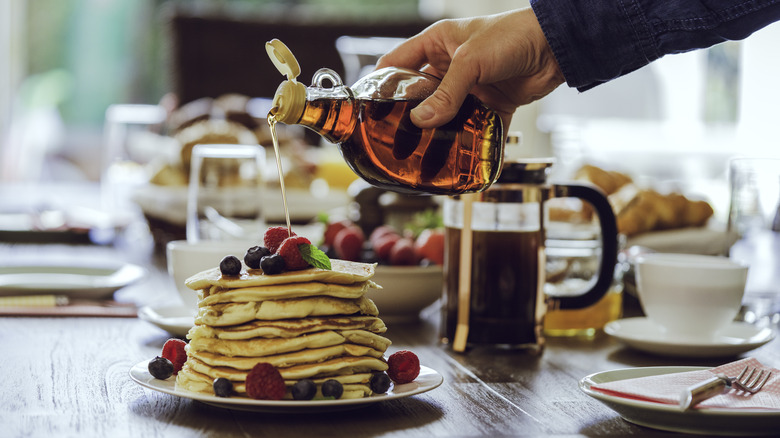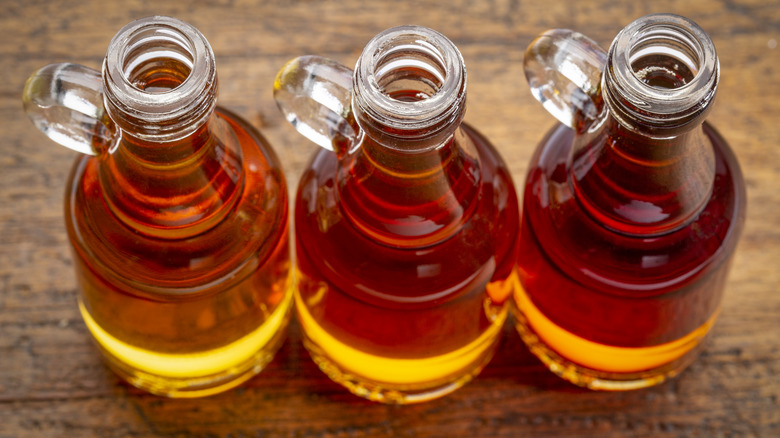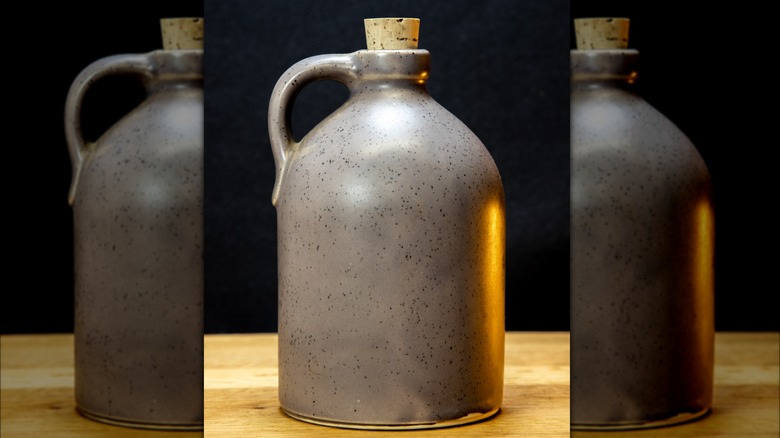Why Most Maple Syrup Bottles Have Tiny Handles
It's a Sunday morning. You're making pancakes — they're ready. The aroma fills the kitchen. This is the moment you've been looking forward to all week long. Too bad you can't fit a single finger through the handle on your maple syrup bottle. You either have to clutch the bottle around its middle like a caveman, or grab the miniature handle with two fingers pincer-style and hope you don't drop it. What's with maple syrup bottles and those tiny, sub-functional handles?
Before plastic was the dominant food packing material, it was glass, and before glass, it was stoneware. In the late 1800s, Canadian households stored their liquid foodstuffs in heavy ceramic jugs with handles, making them easier to carry. The design choice made sense for carrying a jug containing up to five pounds of syrup but becomes pretty useless when shrunk to a smaller scale and attached to a slender bottle that can easily fit in the palm of your hand. Some historians have suggested that the design element was purely for nostalgia points, and it just ended up sticking around. When maple syrup companies started designing their products, the tiny handles were added for marketing purposes as a callback to those beloved ceramic crocks and a pull on the heartstrings of Canadian consumers.
Pour one out for yore
In biology, "vestigial structures" are parts of organisms that no longer serve a function. The tailbone, for instance, is thought to be a leftover remnant from some version of humans that used to have large prehensile tails, but after centuries of evolution, now all the tailbone seems to be good for is getting broken after a fall. Call it human nature, but people have kind of a hard time letting go of the past.
As scientist, author, historian, and videographer Hank Green explains, when it comes to physical objects and icons, this phenomenon is referred to as "skeuomorphism," when we "hold on to the design element to remind us of what the thing was like and is doing." It's the same reason why the "recycle bin" on laptops looks like a wastebasket filled with crumpled-up pieces of paper, or why smartphone cameras make the shutter sound when they take a photo.
These days, the tiny maple syrup handle is indeed more symbolic than utilitarian. Mrs. Butterworth's maple syrup is packaged in a woman-shaped bottle, and Log Cabin maple syrup used to come in detailed glass bottles shaped like miniature log cabins — neither design of which featured a little handle.
Sentimental saps
Vintage Pyrex and retro 1950s-style appliances from brands like Smeg are here to stay in contemporary kitchens. Supper clubs are even enjoying a comeback. And even back in the early 1900s, appeal to nostalgia was very much a thing. The tiny-handle decorative element was a nod to the past — if an erroneous one. As Jean-François Lozier, French North American history specialist and a curator at the Canadian Museum of History, explained to Reader's Digest Canada, the large ceramic jars after which the maple syrup jugs were modeled typically held other liquid goods, like liquor and molasses. In actuality, these jars were seldom used to hold maple syrup at all. Still, as Lozier notes, the point of the design was more about sentimentality, which warrants a willing suspension of disbelief: "[Maple syrup companies] were tying in the image of maple syrup with their product and the image that people still had of those crocks in the 19th century."
The iconic tiny handle design comes from Brooks D. Fuerst of Sylvania, Ohio. He applied for a patent in June 1949, and secured it in February 1951. The first company to start selling maple syrup in Fuerst's flask was Cary Maple Sugar Company of St. Johnsbury, Vermont in 1950. At the time, syrup came in 2-ounce, 8-ounce, and 24-ounce sized versions of the bottle. Sounds pretty cozy, right? Not so fast. This seemingly innocuous little jug has a murky origin story.
History of the tiny handle design
Prior to his maple syrup bottle design (artfully named "jug or the like"), Brooks D. Fuerst was an experienced commercial artist working with the Owens-Illinois Glass Company and the Libbey Glass Company in Toledo, Ohio producing different shapes of glassware intended for food storage.
Incidentally, the designer's older brother Edwin Fuerst was a commercial glassware designer, too — and he might have invented the "Fuerst flask" first. (Try saying that three times fast.) In 1933, Edwin locked down a patent for "design for a jug," an oblong bottle with a wide, flat bottom for maximum stability, and (of course) a small functionless handle attached to the neck. In the U.S., the Cary Company was peddling syrups in the 1933 Fuerst flask, while Quebec Maple Products, LTD sold the bottle design to customers in the Canadian market. Still, Edwin's patent expired 14 years later, so Brooks' 1951 "invention" was fair game.
That said, the Fuerst brothers might not have even been the first ones to come up with the tiny handle design at all. Even earlier in 1922, Joseph Klein was awarded a patent for the syrup bottle design used by the Little Brown Jug Products Company, and it featured the useless little handle as well. Either way, as foodies today get to daydreaming about their favorite maple syrup recipes, that annoying little handle might start to look like more of a reminiscent ode to the past than a nuisance.



